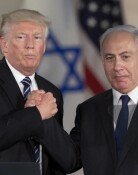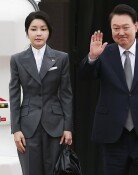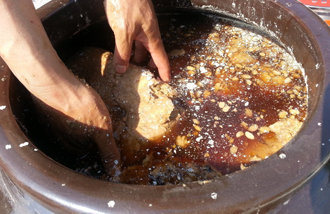Do controversies over kamikaze exhibition stem from ignorance?
Do controversies over kamikaze exhibition stem from ignorance?
Posted March. 13, 2015 07:14,
"What do you think about it?"
The simple question was asked of visitors to an exhibition at the Seoul Museum of Art on Tuesday afternoon.
"It is crazy to put something like this for public viewing in the heart of Seoul," a man in his 40s answered. "This might give an anti-war impression at first glance, but it is nothing more than a romantic reminiscence by a Japanese artist of Japan`s past atrocities."
This is a gist of the interviews at the site. There were many more curse words that were not suitable for being published.
The exhibition entitled "The Subtle Triangle," which opened at the museum on Tuesday, featured Japanese artist Koizumi Meiro`s 2009 video work "Portrait of a Young Samurai," which depicts a young Japanese man saying goodbye to his family before embarking on a kamikaze mission. Another work by the artist contains some Japanese citizens` remarks that Japan had to choose to invade other countries and that they respected the "heroes" at Pearl Harbor who sacrificed their lives for their country.
After the Dong-A Ilbo reported on controversies over the exhibition, the museum sent an e-mail message to art reporters at various media companies. In the message entitled "Japan`s Self-Reflection on Past History through Art," the museum argued that the video invoked anti-war consciousness and that the last scene showed the mother`s painful cry for a reversal in which an international war led to individuals` tragedies.
However, the museum admitted that it had expected controversies. There were questions about the controversial elements of the video at a news conference before the opening of the exhibition. At that time, Koizumi ambiguously said, "It seems that my life overseas since childhood allowed me to look at Japanese society from a more objective perspective." After the controversies erupted, the museum said in a follow-up statement that the video was intended to show the "inconvenient and dangerous reality" of Japanese society where the word "kamikaze" is considered "heroic."
Although the museum and the Japanese artist said that many Korean viewers misunderstood the work and failed to read the "anti-war message," it is completely up to the viewers to decide how to interpret the work on display. It is arrogant to dismiss unintended reactions as misunderstanding stemming from artistic ignorance.
I want to ask them how many South Korean viewers would think about "tragedies of war" after seeing in the middle of Seoul a conversation between a kamikaze agent who says he is happy to die for a noble cause and his mother.
sohn@donga.com
Headline News
- Security strengthened at residences of U.S. presidential candidates
- Late-night announcement issued on Pres. Yoon’s public address
- Green Belt in Seoul to be released in 12 years
- Meta fined 20 billion won for illegally collecting sensitive information
- Culture Ministry calls for severe disciplinary action against KFA chair







